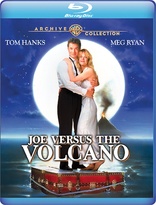Joe Versus the Volcano Blu-ray Movie
HomeJoe Versus the Volcano Blu-ray Movie 
Warner Archive CollectionWarner Bros. | 1990 | 102 min | Rated PG | Jun 20, 2017
Movie rating
6.8 | / 10 |
Blu-ray rating
| Users | 4.4 | |
| Reviewer | 4.5 | |
| Overall | 4.4 |
Overview
Joe Versus the Volcano (1990)
When a hypochondriac in a dead-end job learns that he is dying, he accepts an offer to throw himself in a volcano in exchange for a fleeting taste of the good life.
Starring: Tom Hanks, Meg Ryan, Lloyd Bridges, Robert Stack, Abe VigodaDirector: John Patrick Shanley
| Romance | Uncertain |
| Comedy | Uncertain |
| Adventure | Uncertain |
Specifications
Video
Video codec: MPEG-4 AVC
Video resolution: 1080p
Aspect ratio: 2.40:1
Original aspect ratio: 2.39:1
Audio
English: DTS-HD Master Audio 5.1 (48kHz, 24-bit)
Subtitles
English SDH
Discs
Blu-ray Disc
Single disc (1 BD)
Playback
Region free
Review
Rating summary
| Movie | 4.0 | |
| Video | 4.5 | |
| Audio | 4.5 | |
| Extras | 1.5 | |
| Overall | 4.5 |
Joe Versus the Volcano Blu-ray Movie Review
The Long and Winding Road
Reviewed by Michael Reuben June 22, 2017Joe Versus the Volcano was the first film directed by John Patrick Shanley—and he didn't make
another for eighteen years. A rising star among New York playwrights, Shanley was snapped
up by Hollywood in the Eighties, where he promptly experienced both highs and lows. His first
two screenplays to be filmed were released in 1987. One, Five Corners, quickly disappeared. The
other, Moonstruck, became a box office hit and
a cinema classic, winning three Oscars, including
one for Shanley's script.
Moonstruck was followed two years later by The January Man, a commercial and artistic disaster
that reaffirmed for Shanley the dangers of surrendering his idiosyncratic creations to a director
who did not share (or understand) the author's vision. With Joe Versus the Volcano, Shanley
assumed total control of a project for the first time, with an extra measure of protection provided
by executive producer Steven Spielberg, whose Amblin Entertainment produced the film.
Released in March 1990, Joe didn't lose money, but the audience response was tepid, and the
box office was modest, especially for an Amblin release. The film was marketed as a romantic
comedy on the strength of stars Tom Hanks, who was still known primarily for comedic roles
like Big, and Meg Ryan, who had been propelled to the pinnacle
of rom-com heroines by When
Harry Met Sally . . .. But audiences who showed up for Joe expecting two hours of frothy
diversion found instead a shaggy dog story that mixed erudite references with outright silliness
and frequently left viewers uncertain whether the filmmaker was trying to elicit laughter or
disdain. One critic compared Joe to Howard the
Duck, which was Eighties shorthand for an
epically ill-conceived studio flop.
Joe is one of those films that improves with age, and its fanbase has steadily grown over the
years. The fans' patience has been rewarded with a superb new Blu-ray presentation from the
Warner Archive Collection that renders Shanley's singular fantasy in all its cockeyed glory.
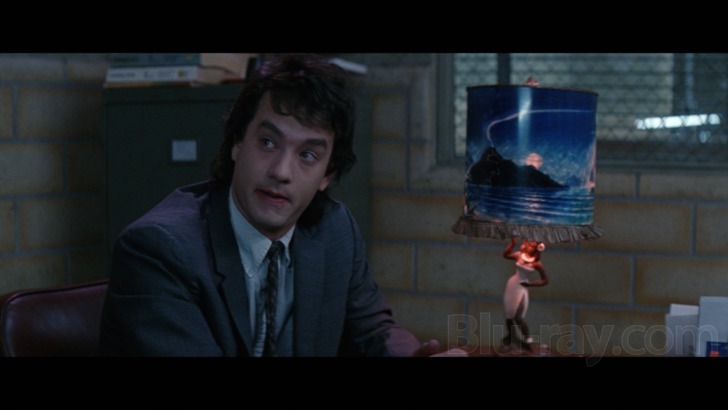
Joe Versus the Volcano depicts the odyssey of New York office worker Joe Banks (Hanks) as he embarks on a voyage that will transform him from a downtrodden corporate drone into—well, into something else. It's appropriate to dub Joe's story an "odyssey" because Homer's epic is one of the three books he keeps at his desk, along with Robinson Crusoe and Romeo and Juliet. All of these share thematic elements with the film's narrative, but is the overlap ironic and satirical, or is it meant to ennoble Joe's fumbling attempts at finding meaning in life? With Shanley, it's probably both.
"I'm losing my sole", Joe explains to a co-worker as he fumbles with one shoe, and the double entendre is both revealing and intentional. Formerly a heroic fireman (like January Man's Nick Starkey), Joe has attempted to settle into the kind of steady, reliable job that was probably his notion of what an adult is supposed to do. He now works for American Panascope in a grimly dilapidated factory that is steadily making him sick. The company manufactures rectal probes—yes, really—and it is introduced in an opening montage of its employees trudging to work in a slow-motion lockstep that unmistakably invokes Fritz Lang's Metropolis. Bullied by his walking caricature of a boss (Dan Hedaya) and too shy to declare his affections for a bedraggled co-worker named DeDe (Ryan, in the first of three roles), Joe spends inordinate time and money on doctors, and one of them has bad news for him. In a sober tone, Dr. Ellison (Robert Stack), informs Joe that he has only months to live—but the upside is that his fatal condition, a so-called "brain cloud", is one of those ideal movie diseases that will leave him in perfect health, without pain or impairment, until very near the end.
Reeling from this news, Joe is recruited by an enthusiastically eccentric industrialist, Samuel Graynamore (Lloyd Bridges), for a unique job opportunity. To acquire mineral rights on the South Pacific island of Waponi Woo, Graynamore has made a deal with the local tribe to supply a willing human sacrifice to appease the island's volcano by leaping into it. Joe's trip to the island will be all-expenses-paid and first class at every turn. What better way for a dying man to spend his final days, and what better ending for a former hero whose finest moments involved running into fires?
Joe's trip to Waponi Woo traces a wandering path that is foreshadowed in the film's recurrent zigzag motif, which begins with the crooked sidewalk outside American Panascope and reappears so often that spotting it could easily be a drinking game. Along the way, Joe receives sartorial advice and life lessons from the soft-spoken chauffeur he hires for his last day in New York (Ossie Davis), and he is outfitted for his travels by a zealous luggage salesman (Barry McGovern), who declares, without a hint of irony, that luggage "is the central preoccupation of my life". Joe endures cataclysms of nature and betrayals by man and, when, against all odds, he reaches his island destination, he is greeted by the chief of the Waponi (Abe Vigoda) with a dejected demeanor that contrasts sharply with his colorful attire and brightly painted face. The confusion of moods may have something to do with the fact that the Waponi are said to be descended from an unlikely of combination of Romans, Druids, Jews and Polynesians. (They're also addicted to orange soda.)
Joe's most consequential encounters in his final days are with Samuel Graynamore's two daughters, Angelica and Patricia (Ryan, in her second and third roles), who are emphatic that they are only half-sisters. As with so many elements in the film, the two women are a study in contrasts. The red-headed Angelica speaks with an affected L.A. accent that is equal parts Katharine Hepburn and Valley Girl, introduces herself as a "flibbertigibbet" and has lost any vestige of self-respect by living off her father's money. The blonde Patricia, on the other hand, is commonsensical and deeply suspicious of her father, and she has done her best to remove herself from the Graynamore orbit. Only the prospect of taking possession of her father's yacht, the Tweedledee, which will ferry Joe to Waponi Woo, is enough to entice Patricia temporarily back into the family fold. Afterward, she plans to sail away forever. Joe can relate to Patricia's urgent need to escape oppressive circumstances, and he quickly falls in love—which is inconvenient, as Patricia's job is to transport him to his death. As Joe says just before heading up the zigzag path to the volcano's edge, "the timing stinks".
Shanley keeps this twisted tale and its outsized personalities poised on the brink of self-parody, aided by witty dialogue, unexpected plot turns and a production design (expanded by endearingly quaint pre-CG effects from ILM) that lends Joe's magical-realist world a convincing heft and substance. But essential to the film's coherence is the skilled central performance by Hanks. Still a few years away from being (re)discovered as a serious dramatic actor, Hanks endows his unlikely character with a relatable everyman quality, thereby conferring a measure of credibility on the increasingly improbable events transpiring around him. (Anyone who can keep a straight face during Nathan Lane's clowning performance as The Waponi Front Man deserves some kind of award right there.) Shanley's script provides Hanks with his own share of comic riffs, especially when Joe quits by telling off his boss and trashing his office (thereby fulfilling a fantasy no doubt shared by at least half the audience), but it's Hanks's ability to react believably in the craziest of situations that solidifies Joe Versus the Volcano as a modern-day fable about living life "in a state of total amazement" (to quote Patricia). Whether you think Joe ultimately achieves that state depends on how you feel about the film's ending, over which Shanley struggled, ultimately opting to leave much of it to the viewer's imagination.
Joe Versus the Volcano Blu-ray Movie, Video Quality 

Joe Versus the Volcano was photographed by Stephen Goldblatt, the versatile cinematographer
whose stylish work encompasses sci-fi (Outland),
action (Lethal Weapon 1 and 2
), drama
(Closer) and comedy (The Intern). Even though home video was well-established by 1990 and
pan 'n' scan ruled the day, Goldblatt and his director used the entire widescreen frame for Joe.
They also employed deliberately artificial and theatrical lighting in a variety of scenes, such as
the moment when Joe and DeDe exit a restaurant and step out into a city that looks like a backlot
set for a musical, complete with a random sailor lounging against a street lamp (screenshot 19).
The cinematography routinely adds diffusion in various forms, including smoke, fog and rain,
all of which soften the image. Additional softening occurs in the many sequences with special
effects, which were achieved through optical superimposition. The degree of softening can be
observed in the opening sequence inspired by Metropolis,
which has the film's credits optically
superimposed, imparting a softer, grainier texture (see screenshots 6 and 10). Such scenes may
prompt criticism of the Blu-ray, but it would be misplaced, as these qualities are true to the
source.
For this 1080p, AVC-encoded Blu-ray, the Warner Archive Collection commissioned a new
scan, which was performed at 2K by Warner's Motion Picturing Imaging Facility using a recently
struck interpositive. An original answer print made on Eastman LPP low fade stock served as a
reference for color correction, followed by cleanup to remove dirt, print damage and similar
flaws. The resulting Blu-ray image is beautifully filmic, reproducing Joe's varying tableaux with
as much sharpness and detail as the source will allow. The film's wildly diverse palette has been
expertly fine-tuned, from the sickly greys, yellows and browns of American Panascope, to the
Christmas tree lighting of the windows in Joe's apartment building (screenshot 20), to the rich
reds and earth tones that crowd the frame as soon as Joe quits his job, to the ever-shifting palette
of the Tweedledee's sea voyage. The island of Waponi Woo is a riot of bright hues, both natural
(forest green), artificial (orange-soda orange) and in-between (the many shades of Waponi face
paint). Blacks are deep and solid, as demonstrated by the tux that Joe dons for his rendezvous
with volcanic destiny.
There are a few instances of banding, but they are fleeting and not overly distracting. As noted
above, grain is more pronounced in some parts of the film than others, but it is consistently well-managed and naturally resolved. WAC has mastered
Joe at its usual high bitrate, here 34.99 Mbps, with a capable encode free of artifacts.
Joe Versus the Volcano Blu-ray Movie, Audio Quality 
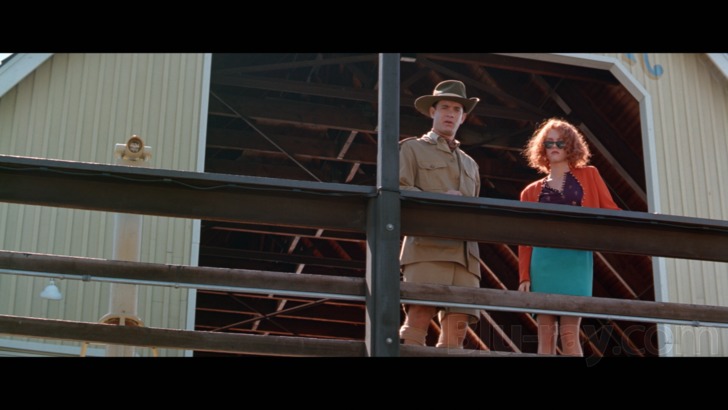
Joe was released to theaters in Dolby Stereo, but the soundtrack was remixed to 5.1 from the original audio stems for DVD. That mix appears on the Blu-ray, but now supplied in lossless DTS-HD MA. The remix is conservative, maintaining the original frontward focus while lending additional clarity to the literate dialogue, which remains firmly anchored to the center. The surrounds provide ambiance and expansion for sequences like the Tweedledee's encounter with a storm at sea. Dynamic range is more than adequate for the demands of Joe's sound mix, which doesn't reach for shattering highs or bone-shaking lows. The original score by Georges Delerue (Platoon) provides a light-hearted counterpoint to events that might otherwise play as tragic, and the soundtrack benefits from an eclectic selection of popular songs, often rendered in oddball variations (e.g., Lerner and Lowe's "On the Street Where You Live", performed by a mariachi band) and/or used to ironic effect (e.g., Merle Haggard's "Sixteen Tons" transformed into a marching dirge in the film's opening).
Joe Versus the Volcano Blu-ray Movie, Special Features and Extras 
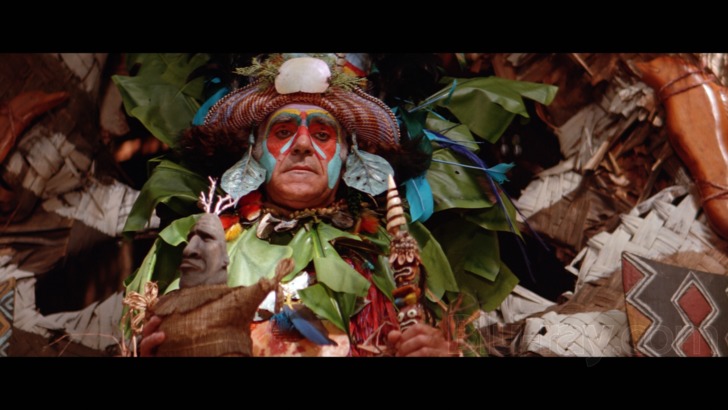
The extras have been ported over from Warner's 2002 DVD of Joe Versus the Volcano. The
trailer has been remastered in 1080p.
- Behind the Scenes Featurette (480i; 1.33:1; 4:24): This is a vintage EPK made for the film's initial release. Hanks, Ryan and Shanley are interviewed.
- Music Video (480i; 1.33:1; 3:56): Eric Burdon, former frontman of The Animals, performs the version of "Sixteen Tons" heard over the film's opening montage.
- Theatrical Trailer (1080p; 1.78:1; 2:15).
Joe Versus the Volcano Blu-ray Movie, Overall Score and Recommendation 
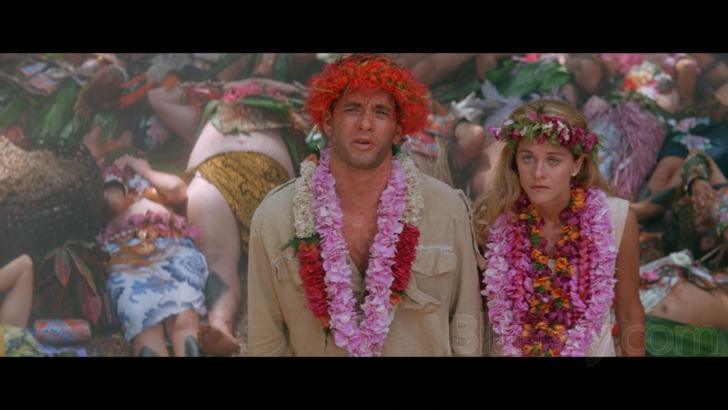
In the years after Joe's release, Shanley wrote the occasional screenplay-for-hire (e.g., adapting
Michael Crichton's Congo for Frank Marshall, another of
Joe's executive producers), but his
focus returned to the stage, for which he authored numerous plays, directing them himself
whenever possible. When he ventured into cinema again, it was to helm the adaptation of his
multi-award-winning play, Doubt, which was nominated for five
Oscars, including Shanley's
script. On the surface, Doubt couldn't be further from Joe, with its fiercely realistic setting in a
Catholic school in the Bronx of the early Sixties and its earnest plot involving allegations of
sexual abuse by a priest. Take a step back, however, and you begin to spot connections between
the desperate curiosity that sends Joe Banks careering on a search for life's meaning and the
zealous quest for truth by an aging nun that ends up shattering all her certainties. In both comedy
and drama, Shanley loves to catch people at moments when they discover that they don't know
what they're doing or even why they're doing it. WAC's Blu-ray of Joe Versus the Volcano
brings one of Shanley's most memorable efforts to Blu-ray with all its wacky charms intact.
Highly recommended.
Similar titles
Similar titles you might also like

Big Stone Gap
2014

Cocoon
1985

What's Up, Doc?
Warner Archive Collection
1972

They All Laughed
1981

Born Yesterday
1993

Return to the Blue Lagoon
1991

Monte Carlo
2011

Fool's Gold
2008

Bridget Jones's Baby
2016

Two If by Sea
1996

All About Steve
2009

Mermaids
1990

Celeste and Jesse Forever
2012

Splash
1984

The Miseducation of Cameron Post
Special Edition
2018

Hello, My Name is Doris
2015

Some Girls
1988

At Middleton
2014

Mr. Peabody and the Mermaid
1948

A Midsummer Night's Dream
1935
